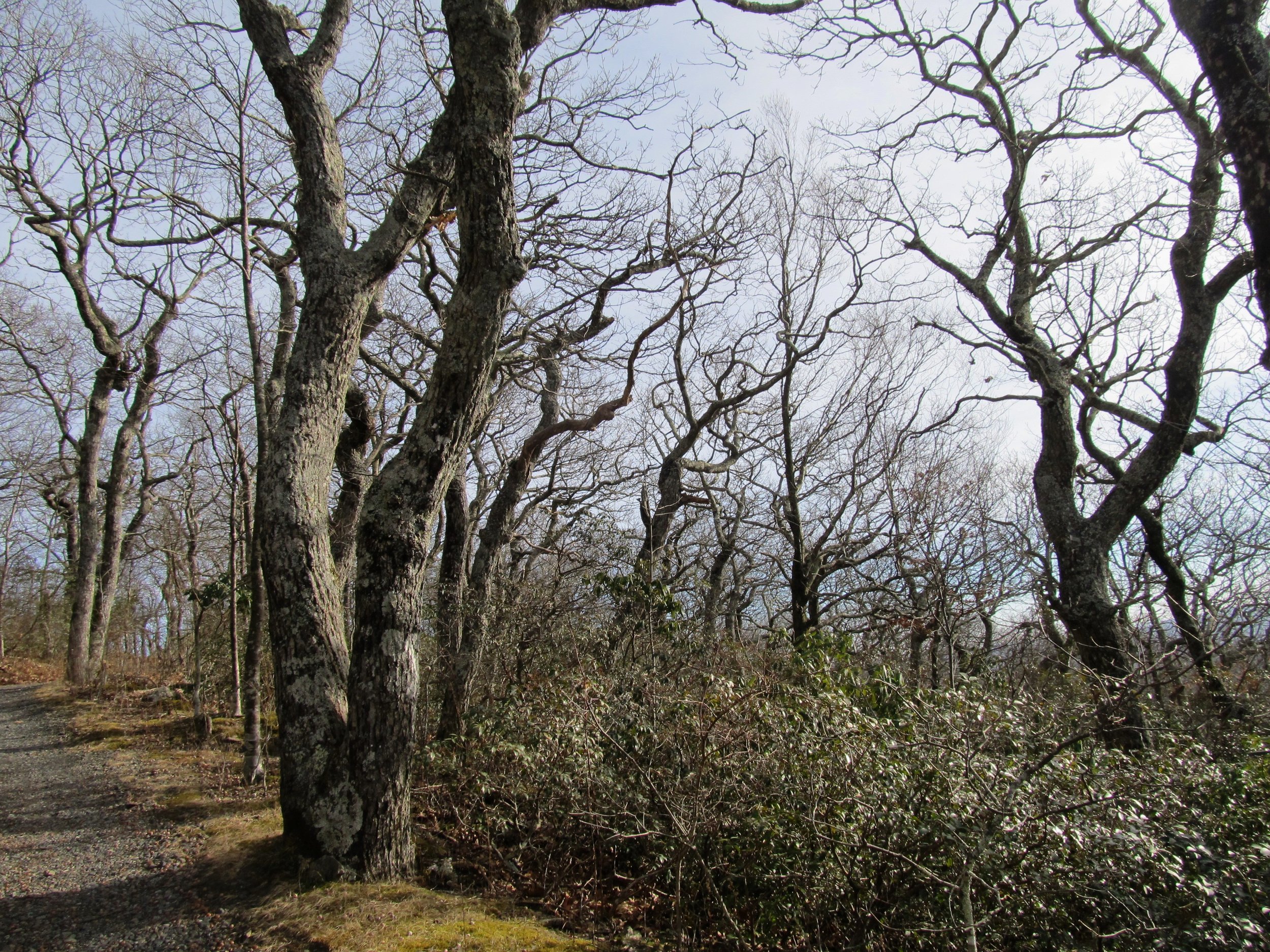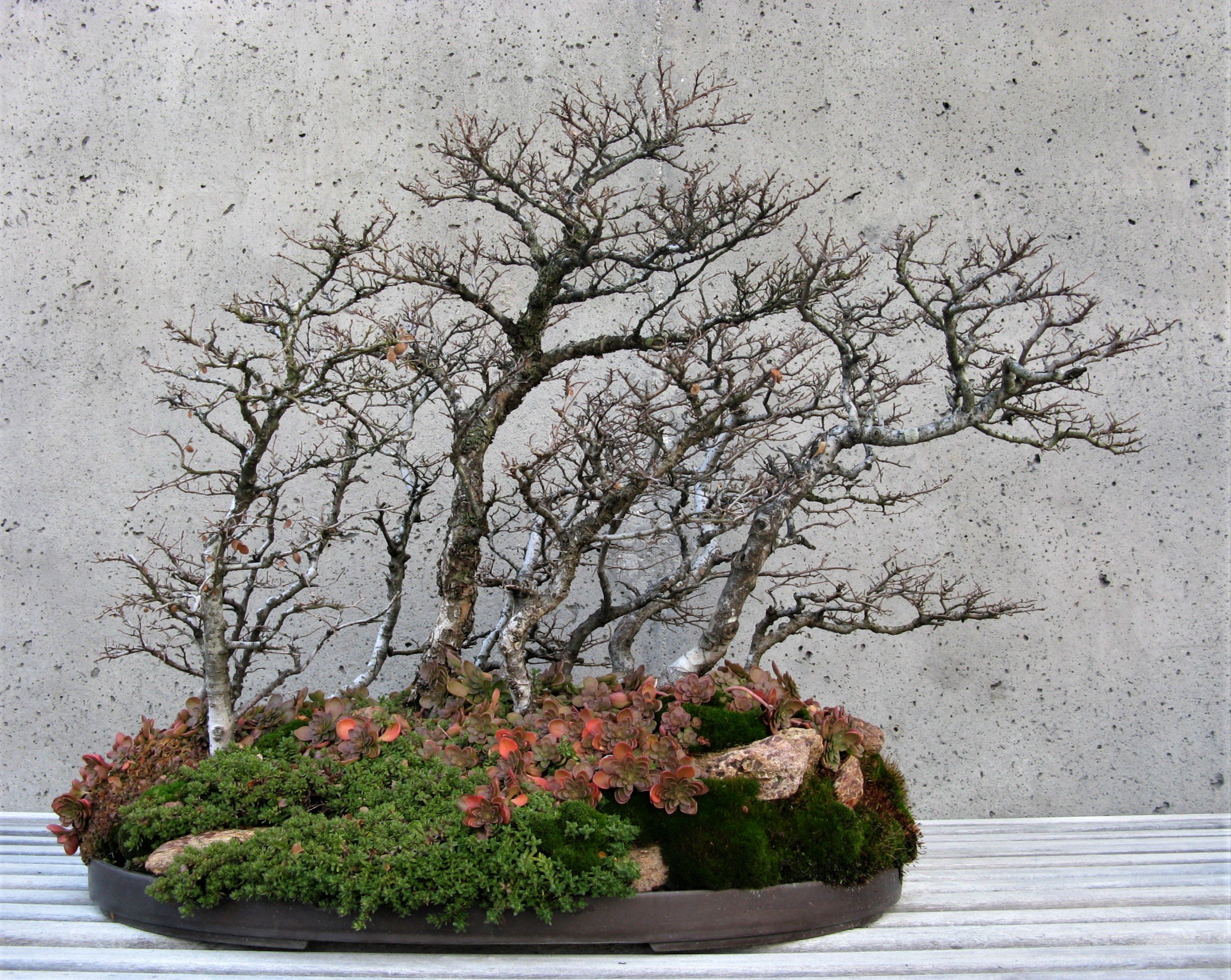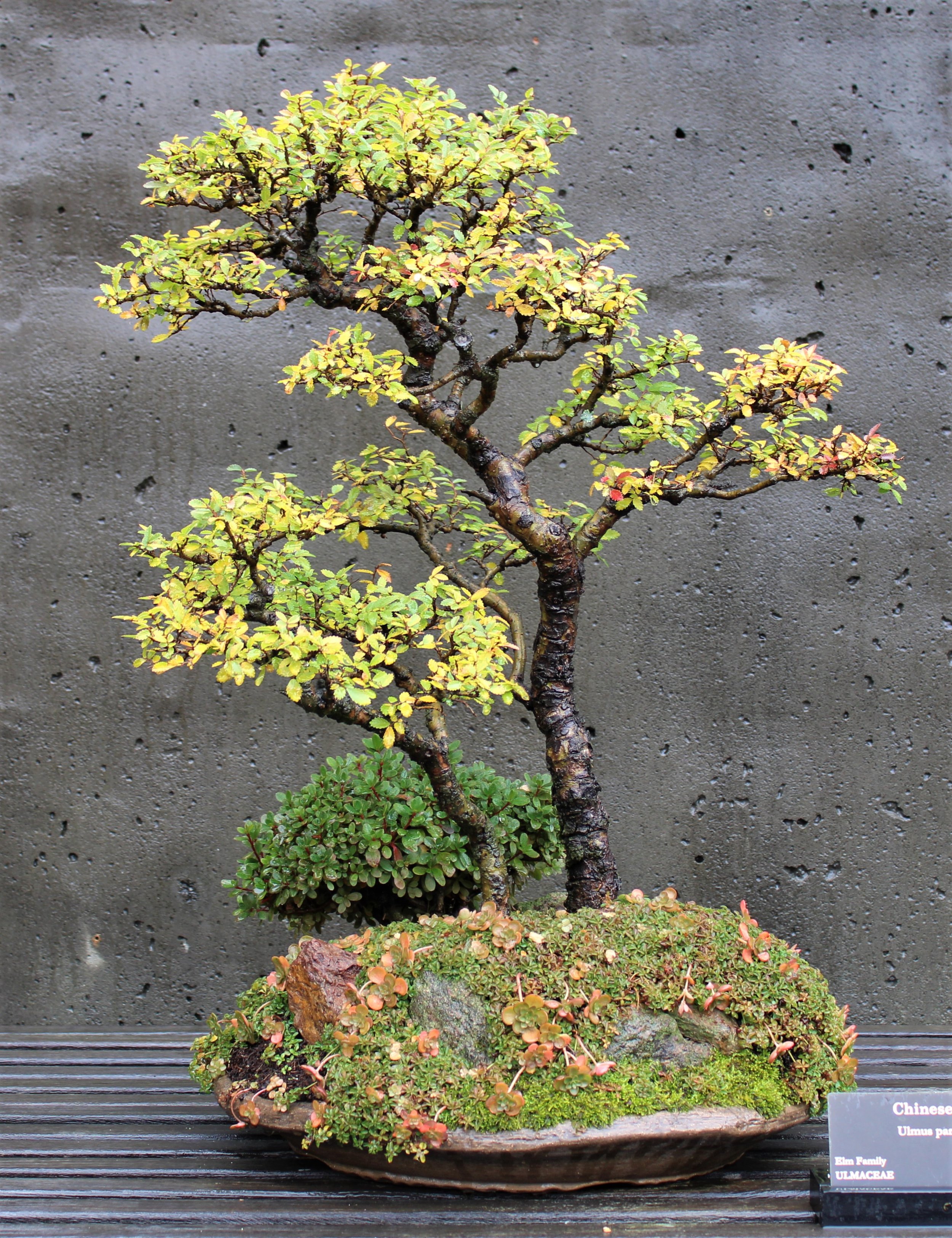Evolution of a Tray Landscape
There were three or four tray landscapes included in the donation that started our bonsai enterprise. They were not so good and most were taken apart at the very start when the initial work was done to stabilize the compromised collection. Still, these pieces caught my attention for being different. One in particular was appealing to me — a group of seven Chinese elms planted on top of and around a large rock:
Looking at the photograph of that planting now I would say it was not very good either, but it was healthier than the other landscapes, and in better condition generally. More importantly, its depiction of a deciduous woodland in a mountain setting presented a scene I recognized. Being entirely new to bonsai at that point I had no concept of bonsai naturalism or tray landscapes, and this planting was not composed with much evident skill, yet the essence of a familiar experience of nature came through. For that reason the elm group was not disassembled, at least not initially.
Details are lost over time as memory fades, and I have to think a long way back for some of this. The elm group was grown as it was for a couple years or so, but it did not prosper and its compositional shortcomings eventually became more bothersome. I decided to give it a makeover. The large rock was retained while the trees were rearranged, and I vaguely recall thinking the new planting was better, although not completely satisfactory. Ultimately it fared no better than its predecessor. It was disassembled without any photo ever being made of it. The trees were potted individually in plastic pots, and the rock, which was heavy and cumbersome, was put aside and has no further part in this story. Somewhere along the way I took cuttings from several of the elms and started new trees. Years went by. Much was happening during this time with the Arboretum and with the bonsai collection and its attendant program, and all the while the elms from the disassembled tray landscape were quietly growing on, out among the burgeoning crop of little trees in the hoop house. The idea of a tray landscape depicting a deciduous woodland in a mountain setting was put on hold, but it was not forgotten.
In 2005 I decided to make another attempt at the same sort of planting, and to do it as a public demonstration at the Carolina Bonsai Expo. My bonsai friends from South Carolina, Ken Duncan and John Geanangel, were my collaborators in this effort, as they often were. We had very good plant material with which to work, because we used the remaining elms from the original tray landscape planting. Those trees were now twelve years older, and to them we added their progeny, the elms grown from cuttings, also substantial by this time. Some small herbaceous plants and a selection of rocks from the Arboretum property rounded out the ingredient list for the new landscape. The demonstration was lively and fun, and I felt good about what we produced. This photograph was made at the conclusion of the program:
This new landscape was working off the same theme as the original landscape, but took the representation in a different direction. Instead of one large rock, which made the original planting heavy and awkward to carry, this version utilized numerous smaller stones. The number of trees was greater in the new planting, and they were given the feeling of being wind-affected. That is, they were pruned and positioned in a way to suggest they grew on a mountain ridgeline, where the prevailing wind came mostly from one direction. Trees in such circumstances never grow tall and straight, but tend to lean in the direction the wind pushes them while amassing more branching on the leeward side.
A short time after, Ken made a computerized image of what he thought the planting might eventually look like:
When I saw Ken's picture I was surprised, because it never occurred to me that the trees should have such a manicured appearance. That close-cropped, dense look is certainly credible, though. It just belongs to a different environment. This image shows oak and holly trees growing on the shore at Fort Fisher State Park, near Carolina Beach, N.C.:
The trees in the above image are in a group, but the group stands isolated in an otherwise open, windswept environment. Trees with this look I would classify as truly windswept in their appearance.
These images show wind-affected trees trees on a mountaintop, at Mount Jefferson State Park, in West Jefferson, N.C.:
The trees in these images are not as fully exposed to the wind because they are partially protected by all the other trees growing in the forest around them. The wind has a noticeable effect on their appearance but they are less than windswept.
The new tray landscape was put together by three people, but only one of them would be taking care of it after that. The person who grows a bonsai, taking care of it day by day over an extended period of time, is the one who ultimately determines its look.
Here is an image made a year after the planting was assembled (note the rocks on the right side have been rearranged):
By 2008 this tray landscape was regularly out on display in the bonsai garden. It had also acquired a poetic name: Wind On the Mountain (Click on any image below for the full view):
The above sequence of images shows the seasonal interest provided by Wind On the Mountain. It will be noted that this planting remained on display, on a bench in the garden, through the winter that year.
For the first ten years after the bonsai garden opened, a small number of bonsai were left out on display through the winter months — a practice we discontinued. Certain species, such as Amur maple (Acer ginnala) and Swiss mountain pine (Pinus mugo), originated in parts of the world much colder than our own and have a considerably higher degree of cold tolerance. Even when grown in pots, roots subject to air temperature and not protected by the warmer, more stable temperature of the earth, these species can typically withstand hard freezing. Other species, even those completely cold hardy in our climate zone when grown in the landscape, are prone to freeze damage when grown in containers. Chinese elm is one of those species not reliably cold hardy when grown in a pot.
Did I know, when I chose to leave Wind On the Mountain out on display all winter, that Chinese elm is not reliably cold hardy when grown in a pot? Yes, I did.
Why did I do it, then? As incredible as it sounds, I think I deceived myself into thinking Wind On the Mountain was something other than what it was. Wind On the Mountain looked so good to me, was such a believable representation of the wild character of the Southern Appalachian highlands, that I thought of it as actually being what it only represented. I forgot that I was looking at little Chinese elms growing in a shallow container and instead imagined them to be big buckeyes and yellow birches growing among the boulders on a windblown ridgeline. The tray landscape looked that believable to me. This seems implausible even as I write it, but we have other Chinese elm bonsai in our collection and I never elected to leave any of them out all winter. Something must have caused me to view these elms differently. Perhaps I rationalized to myself that there were Chinese elms growing right outside the walls of the bonsai garden — the same species not more than a couple dozen feet away — and they had no trouble surviving the winter. But those trees have their roots in the ground and the elms in Wind On the Mountain did not, and I knew the difference. I know it even better now. Leaving the planting out on display all winter was a bad call.
In the spring of 2009 only two of the fourteen trees in Wind On the Mountain put out new leaves. The others had frozen to death. I took the landscape apart, planted the two surviving trees in plastic pots, and stashed away the rocks for another day.
The next chapter in this elm saga began in 2010. I took the leftover parts of Wind On the Mountain and assembled them into a new composition, much smaller than before but telling the same story. Here is the new planting at the end of its first growing season:
The elements were mostly all the same: rugged rocks, craggy trees, herbaceous understory. A dwarf azalea was a new addition, used to suggest a rhododendron or mountain laurel. The intention was once again to take the viewer up to the mountains, to a forest where the trees struggle to grow in a demanding environment. Whereas Wind On the Mountain provided more information in the form of more trees and stones, the new rendition speaks more suggestively. A couple of trees are shown and the viewer fills in the rest of the forest. Or not. Perhaps the viewer prefers to see the scene as being just two trees, isolated on a rocky mountaintop, or standing in an open rocky field. Because less information is given, there is more room for the imagination to roam.
This gallery of images from 2013 shows the landscape in summer, autumn, and late autumn (Click on any image for the full view):
The sight of snow on the bare branches in the third image brings back immediate memories of what happened in the winter of 08/09. Then, the tray landscape was out all winter and the snow fell in early April. In 2013 the snow was the first of the season and came in November, just before the benches in the garden were cleared and all the temperate bonsai were put into their overwintering quarters. No harm was done.
This image from June of 2015 shows the little azalea in bloom:
Here is what the planting looked like at the end of the growing season in 2021:
If you compare the above image with some of the earlier shots of this most recent iteration of the landscape, it will be noticeable that definition had been lost in the crown of the trees, as well as in the little understory shrub. The soil mass had gotten bloated looking, reminiscent of a pan of Jiffy Pop popcorn about to burst open. Small wonder — the landscape hadn't been repotted in eleven years! Tray landscapes typically can go longer between repottings than a single tree bonsai, but a decade is too long.
This spring the situation was addressed. Disassembling the root mass was challenging, requiring the use of a reciprocating saw. The two trees were separated because I no longer liked the way they related to each other. When putting the whole business back together, I took care to establish a better arrangement between the two trunks, and I also redid the rock work and lowered the overall profile of the ground plane. The azalea wound up in a different location, too. The planting had gotten "overripe" due to neglect, which necessitated repotting, which led to an opportunity to tinker with the composition. This subtle redesigning was informed by years of looking at the bonsai, thinking about it, and watching it grow and change of its own accord. I feel good about where this tray landscape is at right now, all things considered, but I don't think its development is complete. I know it can be better. Time and new growth will determine what comes next.
A nearly thirty year evolution in three images (Click on any image for full view):























